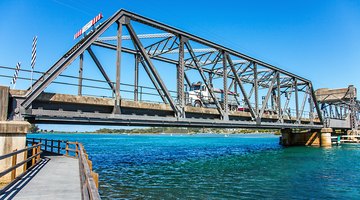Different Types of Truss Bridges
The truss bridge is one of the oldest bridge designs in the United States. Utilizing wood or steel, the truss bridge is stressed from tension and compression in order to hold loads. The first wood truss bridge in the U.S. was built in 1820; steel truss bridges were not built until after 1850.

Each new evolution of truss bridge brought about different types of truss bridge designs.
Pratt
The Pratt truss bridge utilizes diagonal and vertical beams. Each diagonal beam slopes in the downward direction toward the middle of the bridge. The downward beam attaches to a vertical beam, making a sideways "Z" shape along the length of the bridge. Once the structure meets in the middle, it forms more of a "V" shape. These truss bridges do not span more than 250 feet. Most of the early railway bridges had the Pratt design.
Howe
The Howe truss bridge is similar to the Pratt design with only a few differences. Instead of the diagonal beam sloping downward into the vertical beam, the diagonal beam slopes upward. Once reaching the middle of the bridge, the diagonal beams make a upside-down "V" shape. The vertical beams create tension while the diagonal beams create the compression, holding the load of the bridge. Many railway bridges are also built with this type of design.
K Truss
The K truss bridge literally makes a backward 'K" shape along the structure of the bridge. The middle looks like two K's back-to-back. Many engineers consider the K truss design one of the most complicated. The vertical beams have two diagonal beams located between each vertical beam, making a sideways "V" shape. The height of the vertical beam does not prevent the diagonal beams from joining halfway up and halfway down the vertical beam.
Bailey
The military utilizes the Bailey design, which is easily disassembled and portable. The Bailey truss bridge allows for many different configurations of the trusses for different environments and spans. Most of the design has vertical members attaching to horizontal members as well as horizontal braces located between the vertical beams.
Warren
The Warren truss bridge only utilizes diagonal beams. The diagonal beams make a "V" shape along the entire span of the bridge. Along the span of the bridge, one diagonal piece goes downward and attaches to a diagonal beam moving in the upward direction. A Warren truss bridge is one of the easiest bridge designs to build.
Bowstring
The Bowstring truss bridge utilizes a arch top beam with vertical and diagonal beams running along the span of the bridge. The arch looks similar to bow shape, hence the bowstring name. Between each vertical beam, two diagonal beams join together making an "X" shape. The bowstring is considered one of the more durable and stronger truss bridges used today.
References
Writer Bio
Mitchell Brock has been writing since 1980. His work includes media relations and copywriting technical manuals for Johnson & Johnson, HSBC, FOX and Phillip Morris. Brock graduated from the University of Southern California in 1980, earning a Bachelor of Arts in English.
More Articles



